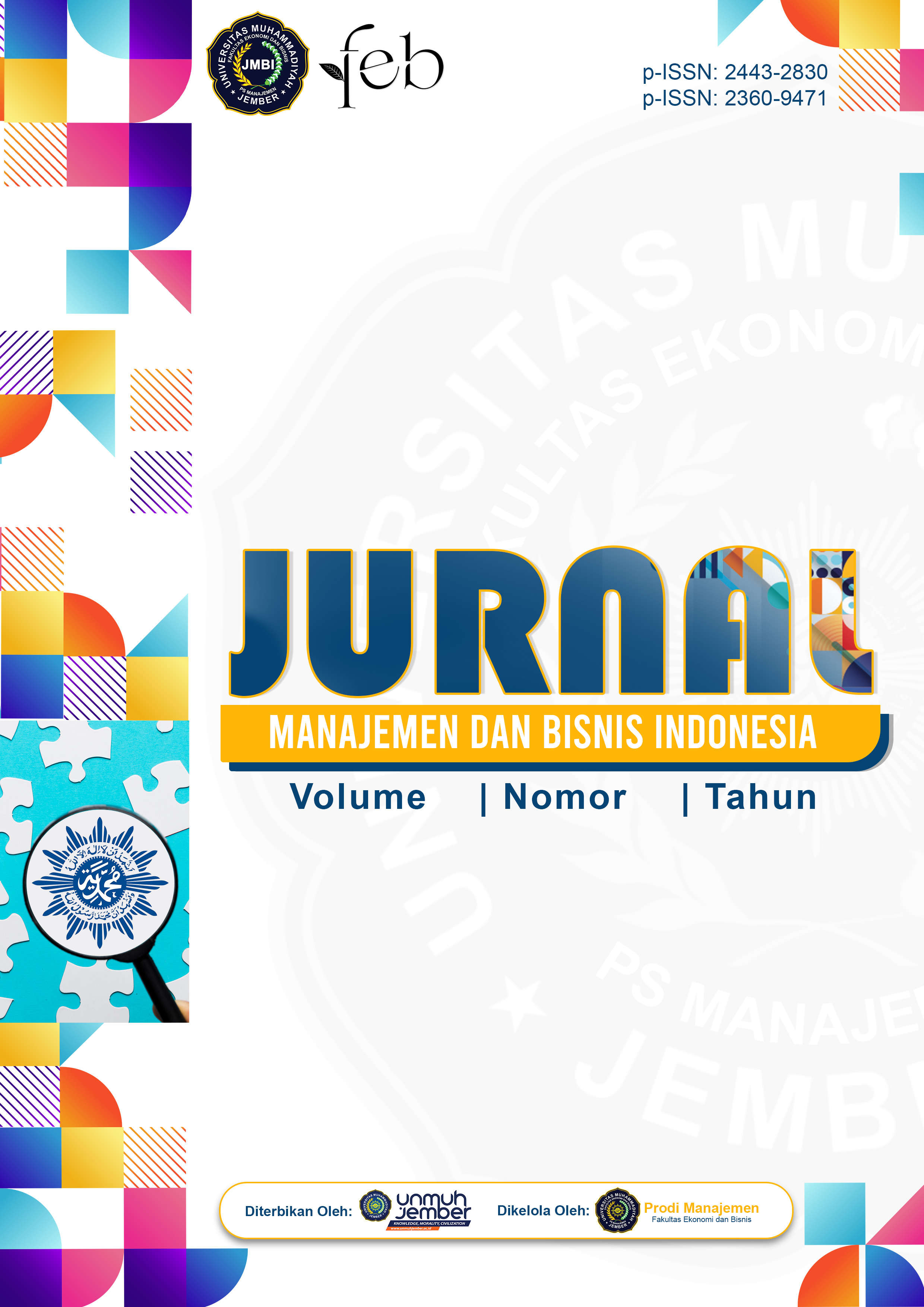Sustainable Marketing Factor: Strategi Peningkatan Kepuasan Dan Loyalitas Konsumen Berbasis E-Commerce Innovation Dan E-Customer Relationship Marketing
DOI:
https://doi.org/10.32528/jmbi.v10i1.1430Keywords:
Kepuasan, Loyalitas Konsumen, E-commerce Innovation, dan E-Custormer Relationship MarketingAbstract
Penelitian ini bertujuan untuk menguji pengaruh E-Commerce Innovation dan E-Customer Relationship Marketing terhadap kepuasan dan loyalitas konsumen. Subjek penelitian ini adalah konsumen Hotel Bintang 3 di Kota Jember Jawa Timur. Populasi penelitian adalah konsumen yang menggunakan jasa hotel di Kota Jember dan penentuan sampel dilakukan secara accidental sampling. Jumlah sampel ditentukan sebanyak 10 kali indikator. Sehingga jumlah responden adalah 20 x 10 = 200 responden. Analisis data dilakukan dengan Structural Equation Model Partial Least Square (SEM-PLS). Hasil penelitian menyatakan bahwa E-Commerce Innovation berpengaruh signifikan baik terhadap kepuasan konsumen maupun loyalitas konsumen, E-Customer Relationship Marketing berpengaruh signifikan terhadap kepuasan konsumen, namun tidak berpengaruh terhadap loyalitas konsumen. Kepuasan konsumen berpengaruh signifikan terhadap loyalitas konsumen. Temuan penelitian ini diharapkan dapat memberikan kontribusi positif bagi entitas bisnis perhotelan khususnya terkait dengan upaya meningkatkan daya saing perusahaan melalui penciptaan loyalitas konsumen.
References
Abu-Shanab, E., & Anagreh, L. (2015). Impact of electronic customer relationship management in banking sector. International Journal of Electronic Customer Relationship Management, 9(4), 254–271.
Alim, S., & Ozuem, W. (2014). The influences of e-CRM on customer satisfaction and loyalty in the UK mobile industry. Journal of Applied Business and Finance Researches, 3(2), 47–54.
Brown, J. R., & Dant, R. P. (2014). The Role of e-Commerce in Multi-Channel Marketing Strategy BT - Handbook of Strategic e-Business Management. In F. J. Martínez-López (Ed.) (pp. 467–487). Berlin, Heidelberg: Springer Berlin Heidelberg.
Chang, J. I., & Lee, C. Y. (2020). The effect of service innovation on customer behavioral intention in the Taiwanese insurance sector: the role of word of mouth and corporate social responsibility. Journal of Asia Business Studies, 14(3), 341–360.
Ergün, H. S., & Kuşcu, Z. K. (2013). Innovation Orientation, Market Orientation and e-Loyalty: Evidence from Turkish e-Commerce Customers. Procedia - Social and Behavioral Sciences, 99, 509–516.
Farmania, A., Elsyah, R. D., & Tuori, M. A. (2021). Transformation of crm activities into e-crm: The generating e-loyalty and open innovation. Journal of Open Innovation: Technology, Market, and Complexity, 7(2).
Fei, Y., Yi, T., Wang, C., & Ching, C. (2021). Enhancing customer satisfaction , delight , and loyalty. Service Business, 15(4), 667–694.
Ferrera, C. ;, & Kessedjian, E. (2019). Evolution of E-commerce and Global Marketing. International Journal of Technology for Business, 1(1), 33–38.
Fornell, C. (1992). Satisfaction Barometer: The Swedish Experience. Journal of Marketing, 56(1), 6–21.
Herman, L. E., Sulhaini, S., & Farida, N. (2021). Electronic Customer Relationship Management and Company Performance: Exploring the Product Innovativeness Development. Journal of Relationship Marketing, 20(1), 1–19.
Hofmann, E., & Osterwalder, F. (2017). Third-Party Logistics Providers in the Digital Age: Towards a New Competitive Arena? Logistics, 1(2), 9.
Hua, N. (2016). E-commerce performance in hospitality and tourism. International Journal of Contemporary Hospitality Management, 28(9), 2052–2079.
Isniah, S., Ikatrinasari, ulfa F., & Husein, T. (2023). Increasing consumer satisfaction and loyalty with product innovation, e-commerce and reward factors. AIP Conference Proceedings, 2485(1).
Iwan, S., Kijewska, K., & Lemke, J. (2016). Analysis of Parcel Lockers’ Efficiency as the Last Mile Delivery Solution - The Results of the Research in Poland. Transportation Research Procedia, 12(June 2015), 644–655.
Magatef, S., Al-Okaily, M., Ashour, L., & Abuhussein, T. (2023). The impact of electronic customer relationship management strategies on customer loyalty: A mediated model. Journal of Open Innovation: Technology, Market, and Complexity, 9(4), 100–149.
Michałowska, M., Kotylak, S., & Danielak, W. (2015). Forming relationships on the e-commerce market as a basis to build loyalty and create value for the customer. Empirical findings. Management, 19(1), 57–72.
Mishra, O. N., & Gupta, S. (2020). Antecedents and Impact of E-commerce Adoption among New Venture Firms: Evidence from Tourism and Hospitality Industry. Vision, 24(4), 431–440.
Mokha, A. K., & Kumar, P. (2022). Examining the Interconnections Between E-CRM, Customer Experience, Customer Satisfaction and Customer Loyalty: A Mediation Approach. Journal of Electronic Commerce in Organizations, 20(1), 1–21.
Oliver, R. L. (2014). Satisfaction: A Behavioral Perspective on the Consumer. New York: Routledge.
Rahman, S., Fadrul, F., Yusrizal, Y., Marlyna, R., & Momin, M. M. (2022). Improving the Satisfaction and Loyalty of Online Shopping Customers Based on E-Commerce Innovation and E-Service Quality. Gadjah Mada International Journal of Business, 24(1), 56–81.
Randhawa, P., Kim, M. R., & Cichy, R. F. (2017). Service Innovations: What the Managers Believe and What the Customers Say. Journal of Hospitality Marketing and Management, 26(2), 186–206.
Rishi, B., Kapoor, A., & Bhatia, S. (2016). AaramShop.com reinventing the e-grocery wheel in India. Emerald Emerging Markets Case Studies, 6(2), 1–28.
Rosário, A., & Raimundo, R. (2021). Consumer marketing strategy and e-commerce in the last decade: A literature review. Journal of Theoretical and Applied Electronic Commerce Research, 16(7), 3003–3024.
Santoso, B., & Alawiyah, T. (2021). Service Quality as A Measurement of Customer Satisfaction of Indonesian Sharia Bank Using Important Performance Analysis Method. International Journal of Social Science and Business, 5(2), 291–296. Retrieved from https://ejournal.undiksha.ac.id/index.php/IJSSB/index
Sheu, P.-L., & Chang, S.-C. (2022). Relationship of service quality dimensions, customer satisfaction and loyalty in e-commerce: a case study of the Shopee App. Applied Economics, 54(40), 4597–4607.
Singh, R. K., & Verma, H. K. (2020). Influence of Social Media Analytics on Online Food Delivery Systems. International Journal of Information System Modeling and Design, 11(3), 1–21.
Soltani, Z., & Navimipour, N. J. (2016). Customer relationship management mechanisms: A systematic review of the state of the art literature and recommendations for future research. Computers in Human Behavior.
Subramanian, N., Gunasekaran, A., & Gao, Y. (2016). Innovative service satisfaction and customer promotion behaviour in the Chinese budget hotel: An empirical study. International Journal of Production Economics, 171, 201–210.
Sugiyono. (2019). Metode Penelitian Kuantitatif Kualitatif R&D. Bandung: Alfabeta.
Suki, N. M., & Suki, N. M. (2013). Examining factors correlated with consumer online shopping behaviour. Cnnovation in the High-Tech Economy, 1(2), 133–141.
Tsagkias, M., King, T. H., Kallumadi, S., Murdock, V., & de Rijke, M. (2020). Challenges and research opportunities in eCommerce search and recommendations. ACM SIGIR Forum, 54(1), 1–23.
Umar, H. (2019). Metode Riset Manajemen Perusahaan Langkah Cepat dan Tepat Menyusun Tesi dan Desertasi. Jakarta: PT. Gramedia Pustaka Utama.
Vakulenko, Y., Shams, P., Hellström, D., & Hjort, K. (2019). Service innovation in e-commerce last mile delivery: Mapping the e-customer journey. Journal of Business Research, 101(June 2018), 461–468.
Zuhri, A., & Akhmad, S. (2022). Effect of E-Commerce Innovation, E-Service Quality, and Product Diversity on Customer Loyalty Through Marketplace Image in Indonesia. SHS Web of Conferences, 149, 01016.
Downloads
Published
Issue
Section
License
Copyright (c) 2024 Nursaidah Nursaidah

This work is licensed under a Creative Commons Attribution-NonCommercial-NoDerivatives 4.0 International License.






